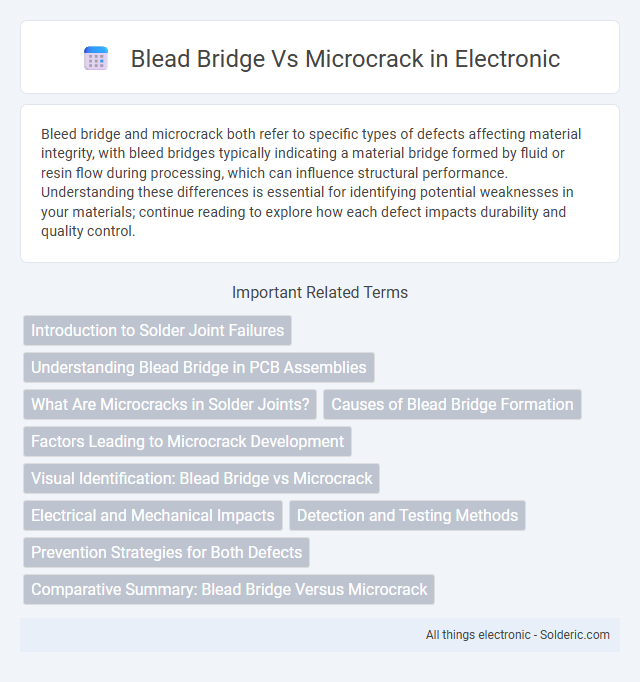Bleed bridge and microcrack both refer to specific types of defects affecting material integrity, with bleed bridges typically indicating a material bridge formed by fluid or resin flow during processing, which can influence structural performance. Understanding these differences is essential for identifying potential weaknesses in your materials; continue reading to explore how each defect impacts durability and quality control.
Comparison Table
| Feature | Blead Bridge | Microcrack |
|---|---|---|
| Definition | Localized section of damaged bridge causing structural weakness | Small-scale cracks in materials or structures, often precursors to failure |
| Size | Larger, visible defects affecting significant bridge areas | Microscopic to millimeter-sized fissures |
| Impact | Severe load-bearing impairment, potential collapse risk | Early indication of material fatigue, possible crack propagation |
| Detection Methods | Visual inspection, ultrasonic testing, structural health monitoring | Nondestructive testing: microscopy, acoustic emission, dye penetrant |
| Repair Approach | Structural reinforcement, partial or full bridge replacement | Crack sealing, surface treatment, stress redistribution |
| Common Causes | Overloading, material degradation, impact damage | Fatigue stress, thermal expansion, corrosion |
Introduction to Solder Joint Failures
Solder joint failures often manifest as either bleed bridges or microcracks, each impacting the reliability of electronic assemblies differently. Bleed bridges occur when excess solder creates unintended connections, leading to electrical shorts, while microcracks are tiny fractures within the solder joint caused by thermal cycling or mechanical stress, reducing conductivity and mechanical strength. Understanding these failure modes is crucial for diagnosing issues in your electronic devices and improving soldering processes to enhance joint durability.
Understanding Blead Bridge in PCB Assemblies
Blead bridge in PCB assemblies refers to excessive solder connecting adjacent component leads, causing unintended electrical shorts that can disrupt circuit functionality. This defect differs from microcracks, which are tiny fractures in solder joints or tracks that may cause intermittent failures due to mechanical stress or thermal cycling. Detecting and preventing blead bridges during soldering enhances PCB reliability by maintaining proper electrical isolation between leads and avoiding signal integrity issues.
What Are Microcracks in Solder Joints?
Microcracks in solder joints are tiny fractures that form within the solder material, often caused by thermal cycling, mechanical stress, or manufacturing defects. Unlike bleed bridges, which involve unintended solder connections creating electrical shorts, microcracks compromise the mechanical integrity and reliability of solder joints by allowing moisture ingress and promoting corrosion. Detecting and mitigating microcracks is critical for ensuring long-term circuit board performance and preventing electronic failures.
Causes of Blead Bridge Formation
Blead bridge formation occurs primarily due to corrosion and mechanical stress on lead-acid battery plates, leading to the merging of lead particles and creating conductive pathways. These bridges form when active material sheds from the positive plate and accumulates in the separator, causing internal short circuits. Unlike microcracks, which are fine fractures in the grid structure, blead bridges develop through the growth of dendritic structures that physically connect positive and negative plates.
Factors Leading to Microcrack Development
Microcrack development in materials often arises from stress concentration, thermal cycling, and mechanical fatigue, which cause localized damage at the microscopic scale. Defects such as inclusions, voids, and grain boundary weaknesses exacerbate the initiation and propagation of microcracks under repetitive loading conditions. Material properties like brittleness, tensile strength, and microstructure significantly influence the susceptibility to microcrack formation, distinguishing it from broader damage mechanisms like bleed bridge failures.
Visual Identification: Blead Bridge vs Microcrack
Visual identification of Blead bridges reveals a distinct pattern of continuous, smooth metallic connections typically spanning fractured areas, unlike microcracks which appear as fine, irregular, and branching lines often barely visible to the naked eye. Blead bridges usually exhibit shiny, reflective surfaces indicating metallurgical bonding, whereas microcracks show duller, matte edges with fragmented boundaries. Your inspection accuracy improves by using magnification tools to distinguish these subtle differences, as microcracks compromise structural integrity more severely than Blead bridges.
Electrical and Mechanical Impacts
Bleed bridges provide a continuous conductive path that can mitigate microcrack-related electrical resistance increases, maintaining circuit reliability under mechanical stress. Microcracks introduce localized discontinuities that elevate electrical resistance and may cause intermittent failures in electronic components. Mechanically, bleed bridges enhance structural integrity by distributing stress more evenly, whereas microcracks act as stress concentrators, accelerating material degradation and fracturing.
Detection and Testing Methods
Detection of bleed bridges primarily involves ultrasonic testing and thermographic imaging, which reveal subsurface anomalies and moisture entrapment in concrete structures. Microcracks are typically identified using dye penetrant inspection and microscopic analysis, highlighting fine surface fractures that can propagate under stress. Advanced non-destructive evaluation tools, including acoustic emission monitoring, provide continuous assessment for both bleed bridges and microcracks, ensuring early detection and preventive maintenance.
Prevention Strategies for Both Defects
Effective prevention strategies for bleed bridges and microcracks in semiconductor manufacturing include optimizing photolithography and etching process parameters to maintain precise feature dimensions and reduce stress-induced damage. Implementing advanced inspection techniques such as electron microscopy and real-time process monitoring helps detect early signs of these defects, enabling timely process adjustments. Material quality control, including resist formulation and substrate surface preparation, further minimizes the occurrence of both bleed bridges and microcracks by ensuring uniform coating and mechanical stability.
Comparative Summary: Blead Bridge Versus Microcrack
Blead bridge defects typically present as localized disconnections within a circuit trace, causing intermittent electrical failures, whereas microcracks are tiny fractures in materials that may progressively degrade structural integrity and electrical continuity. Blead bridges are more easily detected through visual inspection and continuity testing, while microcracks often require advanced imaging techniques such as scanning electron microscopy for identification. The reliability impact of blead bridges is immediate and severe, whereas microcracks pose long-term risks due to propagation under mechanical stress or thermal cycling.
Blead bridge vs microcrack Infographic

 solderic.com
solderic.com